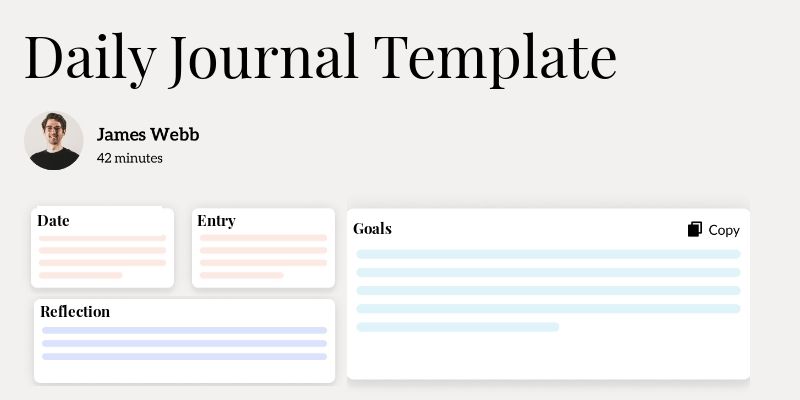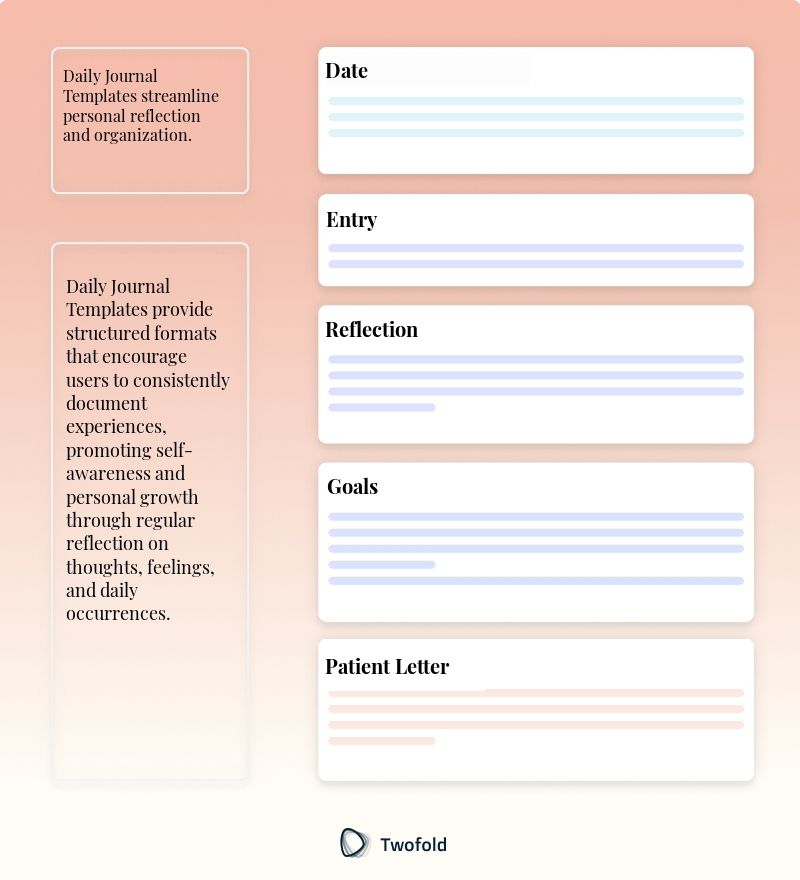
Daily Journal Template
Imagine supercharging your ability to keep track of the day‑to‑day nuances of patient care. With so many details to manage, it can be overwhelming to remember each vital piece of information. This is where a Daily Journal Template becomes a lifeline for healthcare professionals, making the complex task of medical documentation easier and more efficient.
What Is a Daily Journal Template?
A Daily Journal Template structures your medical notes, providing a standard format to capture daily activities, patient interactions, and care data. This template supports healthcare professionals by organizing essential details in an accessible manner.
By standardizing documentation, it minimizes errors and omissions, promoting consistency across all entries. This framework is versatile, adaptable across various medical environments, and facilitates streamlined and efficient patient care.
Key Components of a Daily Journal
The Daily Journal Template should include key elements that support comprehensive documentation:
- Patient Overview: Basic demographics and history.
- Daily Observations: Recorded changes in patient conditions or symptoms.
- Treatment Updates: Any amendments or alterations to ongoing treatment.
- Lab Results: Recent test outcomes that influence care decisions.
- Next Steps: Planned interventions or follow-up actions.

How to Use a Daily Journal Template: Step-by-Step Process
Step 1: Initial Setup
Begin by entering patient information and any necessary history to contextualize the day's notes.
Step 2: Document Observations
Log significant observations, aiming for concise, pertinent details that reflect patient progress or regression.
Step 3: Update Treatments
Record changes in medications or therapies, including dosage adjustments or new prescriptions.
Step 4: Review Lab Results
Input any relevant lab results, ensuring these data points are integrated with ongoing treatment plans.
Step 5: Plan Next Steps
Identify and record necessary follow‑ups, additional tests, or specialist referrals.
Benefits of a Daily Journal
Benefit | Description |
|---|---|
Improved Accuracy | Ensures all patient data is captured consistently and accurately. |
Enhanced Communication | Facilitates clear communication among healthcare teams. |
Time Efficiency | Reduces time spent on documentation, allowing more time with patients. |
Comprehensive Records | Creates complete records that support patient treatment and legal compliance. |
Stakeholders in Daily Journal
Many individuals and groups benefit from a Daily Journal Template in healthcare, each playing a critical role:
- Physicians: Dr. Davis often uses the journal to quickly review a patient's progression over the week before making treatment adjustments, ensuring consistency in care.
- Nurses: Nurse Alex relies on the template for handovers, communicating seamlessly with incoming shifts about patient conditions and care plans.
- Administrative Staff: Sally, the administrative coordinator, uses the template data to manage billing and compliance tasks efficiently, reducing the risk of errors.
- Patients: Patient Robert reviews his care summaries with his family, empowering him to actively participate in his treatment decisions.
Example of a Daily Journal PDF
Here is a snapshot of what a well‑formed Daily Journal entry might look like in PDF format, offering a real‑world perspective on its application.
Real-World Use Cases: Practical Impact of the Daily Journal Template
A properly applied Daily Journal Template transforms patient care across various scenarios:
- The ICU team uses the journal to track patient vitals and interventions round-the-clock, facilitating quick responses to changes in patient status.
- In a rehabilitation center, team members note daily progress and setbacks, adjusting therapy schedules to optimize recovery outcomes.
- A pediatric unit integrates journal notes with educational tips for parents, helping them better understand and care for their children post-discharge.
Conclusion
The Daily Journal Template is an essential tool in the medical documentation toolkit, enhancing accuracy, communication, and efficiency in clinical settings. With careful customization and consistent use, healthcare professionals can maintain high standards of patient care, streamlining their day‑to‑day responsibilities. Embrace the practical benefits of this organized approach to record‑keeping, fortifying the backbone of effective patient care.
Disclaimer: This article is for informational purposes only and does not constitute legal or medical advice. Always consult professional guidelines and regulatory bodies for specific compliance requirements.

Dr. Danni Steimberg
Dr. Danni Steimberg is a pediatrician at Schneider Children’s Medical Center with extensive experience in patient care, medical education, and healthcare innovation. He earned his MD from Semmelweis University and has worked at Kaplan Medical Center and Sheba Medical Center.
A daily journal is more than a diary—it’s a quick‑scan dashboard that turns fleeting thoughts into trackable data for clinicians and clients alike. This method, polished through years of therapy‑adjacent journaling programs, keeps entries short enough to complete yet rich enough to guide treatment adjustments.
- Anchor the Day in 60 Seconds: Begin each page with three check-ins—mood (1-10), energy (1-10), and one-word intention. Clients can fill this in faster than social-media scrolling, giving you hard metrics for spotting patterns.
- Tie Events to Emotions: Add a split column where users jot key moments on the left and immediate feelings on the right. This rapid cause-and-effect mapping makes cognitive-behavioral links pop during session reviews.
- End with a Micro-Win & Next Step: Close each entry with one sentence on the day’s smallest success and one actionable goal for tomorrow. These bite-size reflections reinforce progress, boost adherence, and supply concrete targets for follow-up discussions.
Frequently Asked Questions
Reduce burnout,
improve patient care.
Join thousands of clinicians already using AI to become more efficient.

Action Plan Template
Discover practical Action Plan templates to enhance your documentation efficiency.

Psychiatric Soap Note Template
Discover practical Psychiatric Soap Note templates to enhance your documentation efficiency.

General Physical Exam Template
Discover practical General Physical Exam templates to enhance your documentation efficiency.

